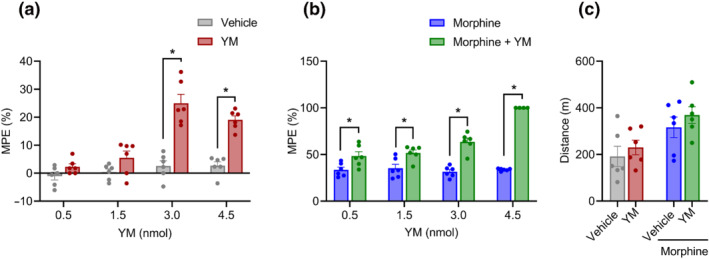FIGURE 3.

The effect of local intrathecal treatment of YM‐254890 (YM) on spinal analgesia and locomotion. (a) Dose–response effect of different concentrations of intrathecal YM (0.5, 1.5, 3.0 and 4.5 nmol) and vehicle was tested on tail immersion test after 30 min of administration. Treatment: F (1, 40) = 81.67; dose: F (3, 40) = 22.93; and interaction: F (3, 40) = 12.19. Two‐way analysis of variance (ANOVA) with Bonferroni's post hoc test. (b) Effect of combined administration of intrathecal YM (0.5, 1.5, 3.0 and 4.5 nmol) with a single low dose of subcutaneous morphine (2.5 mg·kg−1) on the tail immersion test after 30 min of administration. YM was administered 10 min before the administration of morphine. Treatment: F (1, 38) = 185.2; dose: F (3, 38) = 22.00; and interaction: F (3, 38) = 22.88. Two‐way ANOVA with Bonferroni's post hoc test. (c) Changes in cumulative locomotor activity during 120 min of observation in open‐field test by intrathecal administration of YM (3.0 nmol), subcutaneous morphine (2.5 mg·kg−1) and intrathecal YM (3.0 nmol, 10 min before morphine) with subcutaneous morphine (2.5 mg·kg−1)‐treated mice. Treatment: F (1, 20) = 1.35; effect of morphine: F (1, 20) = 11.36; and interaction: F (1, 20) = 0.032. Two‐way ANOVA with Bonferroni's post hoc test. In all panels, statistical analysis was performed combining both sexes, and significance was *P < 0.05; data sets (mean ± SEM) as analysed using two‐way ANOVA with Bonferroni's multiple comparisons test. MPE, maximum possible effect.
